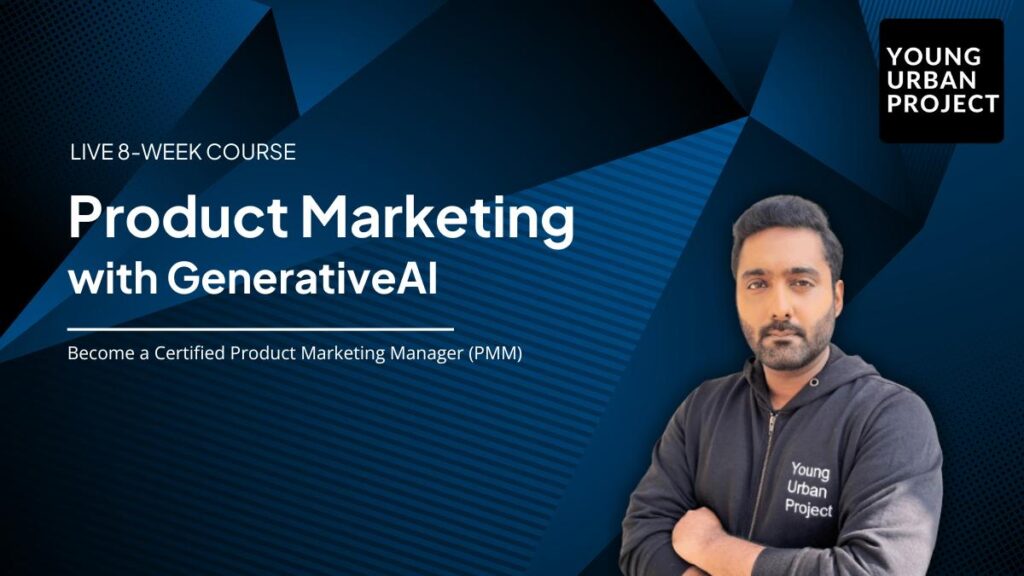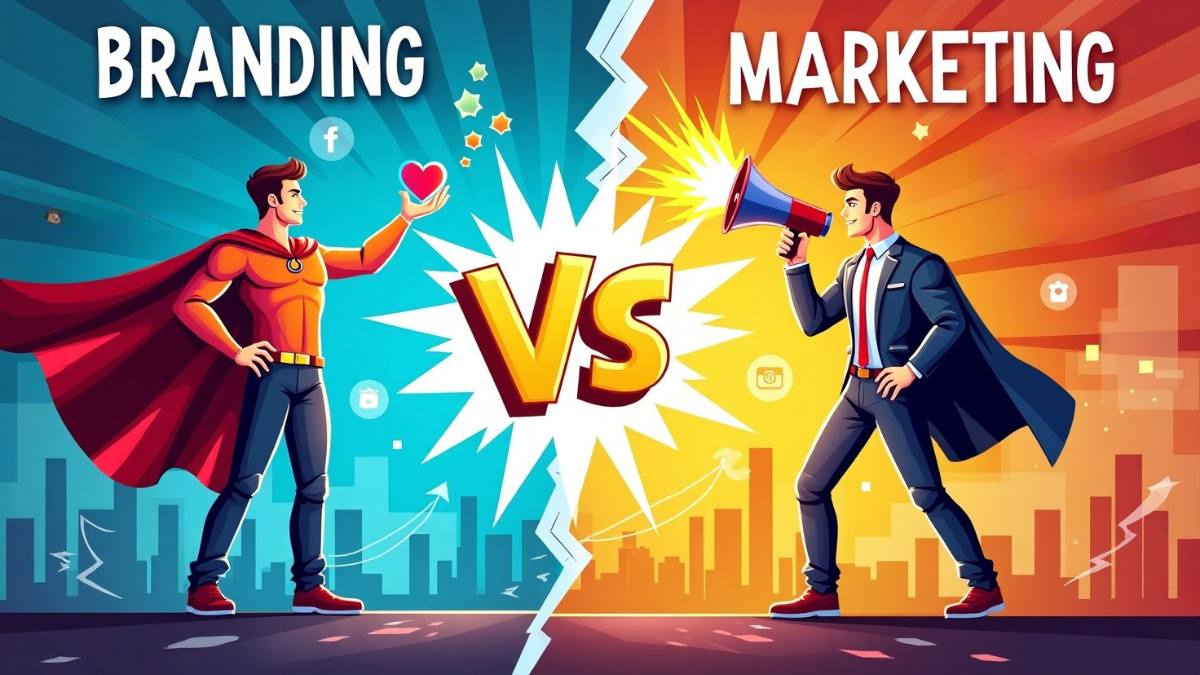Ever wondered why people happily pay ₹1,20,000 for an iPhone but hesitate at a ₹40,000 Android?
Or why folks line up outside Nike stores for a new sneaker drop, even when there are cheaper and equally functional shoes available?
That’s not just good marketing. That’s branding doing the heavy lifting.
On the flip side, ever found yourself clicking on an Instagram ad, intrigued by a brand you’d never heard of, and then ended up buying within minutes?
That’s marketing in action.
Both are essential. But they serve very different purposes. And confusing them can cost businesses time, money, and momentum.
See, in the digital world, where attention spans are short and competition is intense, knowing the difference between branding vs marketing isn’t just a nice-to-have. It’s mission-critical.
Because while marketing gets your product noticed, branding makes it remembered. One drives action, the other builds loyalty. You need both, but in the right order, and for the right reasons.
Let’s break down the difference, and more importantly, how they work best together.
Table of Contents
What is Branding?
Think of branding as your business’s personality. It’s not what you say about your company, it’s what people feel when they encounter it.
Branding is:
- The tone of voice you use on social media.
- The design and color palette of your logo.
- The mission you stand for.
- The feeling someone gets when they interact with your brand, pride, excitement, safety, nostalgia.
It’s the identity of your business.
Key Elements of Branding:
- Logo & Visuals: Your logo, color scheme, typography, these create visual recall.
- Tone of Voice: Playful, professional, edgy, empathetic, how you sound matters.
- Brand Values: What do you stand for? (Think: sustainability, innovation, affordability.)
- Brand Story: The narrative you build over time, through actions and communications.
- Customer Perception: Ultimately, your brand lives in the minds of your audience.
Maybe the most underrated part? Branding is deeply emotional. It’s psychological. It builds trust, creates loyalty, and triggers the “I just love this brand” effect.
You can’t fake good branding, and when done right, you don’t need to scream for attention. Your brand speaks for itself.
What is Marketing?
Now, marketing is how you talk about your brand to the world.
It’s action-oriented.
Marketing is your billboard, your YouTube pre-roll ad, your SEO strategy, your newsletter, all the tools and tactics you use to reach people, grab attention, and drive action.
If branding is who you are, marketing is how you introduce yourself and make people care.
Common Marketing Channels:
Marketing isn’t a one-size-fits-all game, it shows up wherever your audience hangs out. Here are the most common Marketing channels brands use to reach, engage, and convert their customers.
- Digital: Social media, Google Ads, SEO, email marketing, influencer collaborations
- Traditional: TV, radio, print, OOH (out-of-home), PR
- Content: Blogs, videos, podcasts, webinars
- Performance: Lead generation, conversion campaigns, retargeting ads
Marketing campaigns are often time-bound and measurable. You launch, promote, analyze, optimize.
The goal? Awareness, leads, clicks, sales.
Unlike branding, which often operates behind the scenes, marketing is public, tactical, and designed to move people toward a specific behavior, visiting your website, signing up, making a purchase.
Branding vs Marketing – Comparison Chart
| Aspect | Branding | Marketing |
| 1. Definition & Function | Who you are – your identity, voice, values, and personality. It defines how your brand is perceived. | How you engage – the tools, tactics, and strategies used to promote your product or service. |
| 2. End Goal | Builds loyalty and emotional connection. It turns customers into long-term fans. | Drives action – clicks, sales, sign-ups, etc. It focuses on short-term results and measurable ROI. |
| 3. Longevity | Long-term impact – a continuous narrative that grows and evolves with your business. | Short-term campaigns – often time-bound, seasonal, or focused on specific objectives. |
| 4. Audience Understanding | Helps customers understand who you are, what you stand for, and why they should trust you. | Helps brands understand their audience through data, feedback, and analytics. |
| 5. Emotional vs Tactical | Emotional and psychological – it evokes feelings, identity, and connection. | Tactical and strategic – it pushes specific behaviors and drives business metrics. |
| 6. Funnel Position | Primarily supports the top of the funnel (awareness, recall, trust). | Operates across the entire funnel – from awareness to consideration to conversion. |
| 7. Value Creation | Creates perceived value – makes a product feel premium, reliable, or “worth it.” | Communicates and extracts that value through messaging, offers, and outreach. |
| 8. Consistency vs Flexibility | Requires consistency across all platforms (design, tone, experience). | Allows for flexibility and experimentation across different channels and audiences. |

Enroll Now: Live Product Marketing Course
Branding Comes First – Always
Here’s a hard truth that a lot of marketers (especially newer businesses) overlook:
You can’t market something that doesn’t have a soul.
And that’s exactly what happens when you jump into marketing without first building your brand.
Think about it: You can run the slickest Facebook ad campaign, but if your brand looks inconsistent, sounds generic, or doesn’t stand for anything, people will scroll right past it. Or worse, they will click, get confused, and bounce.
Also Read: How Ethical Brand Marketing Builds Real Trust
Why Marketing Without Branding Falls Flat
- You’ll waste ad budget because your message lacks clarity.
- Your creatives will feel disconnected, like every campaign is a different business.
- There’s no emotional anchor. People might notice you once, but they won’t remember you.
It’s like trying to sell a house that’s beautifully advertised but crumbles when someone walks in the door.
Before you even touch ad creatives, you need to get clear on your brand guidelines, your tone, voice, visual identity, core values, and messaging pillars. That’s what gives your marketing direction and coherence.
When you build your brand first, marketing becomes 10x more efficient. Every campaign feels like part of a bigger story, and that’s what sticks.
Also Read: Performance Marketing vs Brand Marketing
Real-Life Examples
Let’s bring this down to earth. Here’s how branding and marketing show up in the real world, separately and together.
Branding Examples
- Apple
You don’t even need to see the logo, you feel when something is Apple. The clean design, the minimalist packaging, the “Think Different” philosophy. That’s branding. It’s baked into every single product experience.
- Nike
It’s not just shoes. It’s empowerment, motivation, and that “Just Do It” attitude. The bold visuals. The powerful stories. They’re selling belief as much as they’re selling gear.
- Zomato
You open the app, and it’s funny, relatable, and very Indian. That tone of voice on their notifications? That’s branding. It’s casual, clever, and hyper-aware of its audience.
Also Read: Zomato Case Study
These brands aren’t just known, they’re felt. And that comes from strong, consistent branding.
Enroll Now: Free Brand Marketing Course
Marketing Examples
- Meta Ads (Facebook & Instagram)
This is pure marketing muscle. Retargeting users, testing creatives, optimizing for clicks. Meta Ads don’t build your brand, they deliver your message if your brand already has one.
Also Read: 13 Types of Facebook Ads
- Email Campaigns
A well-timed offer in your inbox is a classic marketing move. It’s personalized, measurable, and designed to nudge you into action. But again, without a brand voice, it’s just another email.
Also Read: Top AI Email Writers
- SEO
Ranking on Google is a marketing strategy. It’s about being discoverable. But what people find when they click? That’s where branding either shines or flops.
Combined Examples
- Airbnb
Their brand is all about belonging, exploration, and local experiences. Their marketing, from email series to video ads, always reinforces that vibe. You don’t just book a stay, you join a movement. That’s the power of integration.
Also Read: AirBnb Customer Acquistion Case Study
- Spotify
Personalization, creativity, culture. That’s Spotify’s brand. Their Wrapped campaigns? Viral marketing that feels like a gift, and reminds you why you love Spotify in the first place.
Also Read: Spotify Case Study: Innovation, Strategy & Growth
When branding and marketing sync, magic happens. It’s not a competition, it’s a collaboration.
What is More Important: Branding or Marketing
Here’s the classic trick question. People love asking, “Which one matters more?”
But honestly? That’s like asking if oxygen is more important than water. You need both, just at different times, and for different reasons.
If you’re launching a new product or business, branding is your foundation. It shapes your first impression. But without marketing, nobody knows you exist.
On the flip side, if you already have a solid brand but your sales are flat, it’s probably time to ramp up your marketing.
It Depends on Your Stage
- Startups often go all-in on marketing and skip branding, which hurts them in the long run.
- Funded companies usually invest heavily in branding early because they have the runway.
- Bootstrapped brands need to strike a delicate balance, smart, scrappy marketing backed by a clear brand voice.
The answer isn’t one or the other. It’s knowing when to focus on what.
When to Focus on Branding, When on Marketing
Alright, so how do you prioritize? Here’s a simple breakdown based on your business stage:
Startup Phase (0–1)
Focus: Branding first
- Define your mission, voice, and identity.
- Create basic brand guidelines.
- Keep marketing minimal but consistent.
Growth Phase (1–3 years)
Focus: Marketing heavy
- Run ads, test channels, scale what works.
- Use brand elements to stay cohesive.
- Invest in performance + content marketing.
Established Business
Focus: Reinforce brand + optimize marketing
- Revisit branding to ensure relevance.
- Double down on omnichannel marketing.
- Add emotional depth to campaigns.
Budget Tip: If you’re tight on funds, invest in branding once, and use it to guide every low-cost marketing move after.
Also Read: What is Integrated Marketing
Conclusion
Here’s the final word, branding vs marketing isn’t a battle. It’s a partnership.
Your brand is your identity.
Marketing is your amplifier.
One without the other is like showing up to a party with a killer outfit but no way to introduce yourself. Or talking non-stop without ever giving people a reason to care.
So brand smart. Market wisely. And build something people actually remember.
FAQs: Branding vs Marketing
1. Can a business survive with just branding and no marketing?
Not for long. Strong branding builds recognition, but without marketing to spread the word or drive action, growth is slow and unpredictable.
2. How does branding help with customer retention?
Branding creates emotional loyalty. People stick with brands they trust, relate to, or believe in, even when competitors offer discounts or new features.
3. What comes first: branding or marketing?
Always branding. You need to know who you are before you tell others. Otherwise, your marketing feels scattered and forgettable.
4. Do small businesses need branding too?
Absolutely. A clear, consistent brand helps small businesses stand out, even without big budgets. It builds trust and sets you apart.
5. Is digital marketing the same as branding?
Nope. Digital marketing is a set of tools and tactics. Branding is your identity, and those tools only work when they carry a message worth sharing.
6. Can rebranding fix bad marketing?
Sometimes. If your current branding doesn’t resonate or guide your campaigns, a thoughtful rebrand can breathe new life into your marketing efforts, but it’s not a silver bullet.

